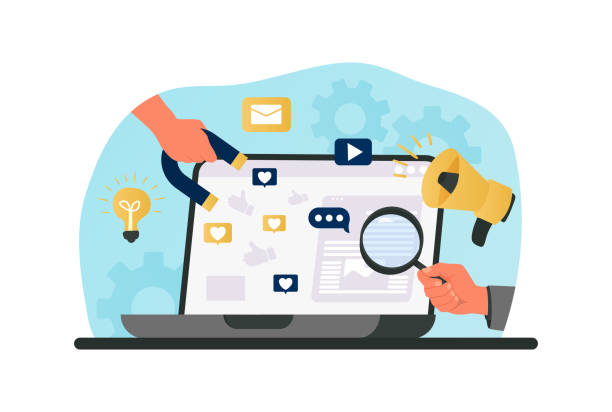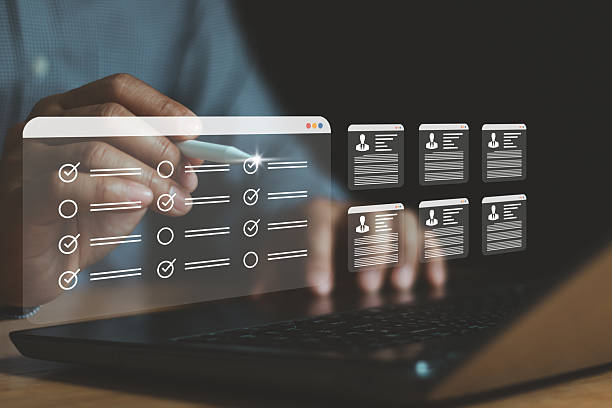The Importance of Secure Website Design in Today’s Digital World

In the current era, where #businesses increasingly rely on their #online_presence, secure website design is no longer an option but an absolute necessity.
Sensitive customer information, financial data, and even your brand’s reputation depend on your website’s security.
An insecure website can open doors for #cyber_attacks, including data breaches, identity theft, and service disruption.
This explanatory section will help you gain a deeper understanding of the consequences of not adhering to the principles of secure website design.
Have you ever considered how much a cyber attack can damage your brand’s reputation and customer trust? Trust is hard-earned and easily lost.
In today’s digital world, customers are more vigilant than ever and expect their information to be protected in a secure environment.
Cybersecurity not only protects your data but also provides peace of mind for your users.
This assurance directly impacts conversion rates and customer loyalty.
Therefore, investing in secure website design is not merely an expense, but a strategic investment for the future of your business.
In the rest of this article, we will show you how to build a completely secure and reliable website using specialized approaches and protect your business from growing threats.
Does losing customers due to your online store’s outdated appearance or slow speed bother you? Rasaweb’s expert team solves these problems with professional e-commerce website design!
✅ Increase customer trust and your brand’s credibility
✅ Stunning speed and excellent user experience
Get your free consultation with Rasaweb right now ⚡
Fundamental Principles of Building a Secure Website
![]()
To create a #secure_website, adhering to #fundamental and basic principles is essential.
These principles include using #secure_protocols, implementing strong #authentication, and proper permission management.
Secure website design must be in the minds of developers and website managers from the beginning, not added as an afterthought.
This is a specialized approach that requires a deep understanding of system architecture and how components interact with each other.
The first step is to use HTTPS, which encrypts communications between the user’s browser and the server via an SSL/TLS certificate.
This initial action prevents eavesdropping on data in transit.
Second, implementing strong authentication mechanisms such as using complex passwords, two-factor authentication (2FA), and secure session management is crucial.
These measures prevent unauthorized access to user accounts.
Third, Authorization management must ensure that each user only has access to the resources necessary to perform their tasks (principle of least privilege).
This access restriction prevents damage from spreading, even if an account is compromised.
Finally, conducting regular security audits and penetration testing to identify and fix potential weaknesses is vital.
These fundamental principles form the backbone of any secure website design project, and adhering to them not only protects your website but also builds user trust.
In this section, we have educationally covered all these points.
Identifying and Countering Common Web Vulnerabilities

Understanding #common_vulnerabilities on the web is the first step to #effective_countermeasures.
This section analytically addresses various threats that can compromise your website’s security.
Attacks such as #XSS, #SQL_Injection, and #CSRF are among the most common ones that developers must consider in the secure website design process.
Understanding how these attacks work and the weaknesses they target is key to protecting your website.
For example, a SQL Injection attack occurs when an attacker injects malicious SQL code through user inputs to access or manipulate the database.
To counter these attacks, Prepared Statements or ORMs (Object-Relational Mappers) should be used.
An XSS (Cross-Site Scripting) attack allows an attacker to inject malicious scripts into web pages that are executed by other users’ browsers.
To prevent XSS, all user inputs must be validated and filtered (Escaping).
CSRF (Cross-Site Request Forgery) also allows an attacker to send unauthorized requests to the server on behalf of an authenticated user.
To counter CSRF, using anti-CSRF tokens in every request is vital.
Below is an educational table of common vulnerabilities and their countermeasures that can help you in the process of securing your website.
| Vulnerability Type | Brief Description | Countermeasure |
|---|---|---|
| SQL Injection | Injecting malicious SQL code to access or manipulate the database. | Use of Prepared Statements/Parameterized Queries, ORM. |
| Cross-Site Scripting (XSS) | Injecting malicious script code into web pages that is executed by the user’s browser. | Validating and filtering (Escaping) all user inputs, use of Content Security Policy (CSP). |
| Cross-Site Request Forgery (CSRF) | Executing unauthorized requests on behalf of an authenticated user. | Use of anti-CSRF tokens, SameSite cookies. |
| Broken Authentication and Session Management | Weaknesses in user authentication and session management. | Use of two-factor authentication (2FA), secure session management, password encryption. |
| Insecure Deserialization | Vulnerability due to insecure processing of serialized data. | Do not accept serialized data from untrusted sources, use more secure protocols. |
Best Practices for Secure Coding and Prevention

One of the most important aspects of secure website design is #secure_coding.
This section provides comprehensive guidance for developers to prevent many vulnerabilities in the early stages.
Following the principles of defense in depth means that security must be considered at every layer of programming, not just the outer layer.
#Input_validation, #output_filtering, and using #strong_encryption for sensitive data are among the requirements for secure coding.
Any data received from the user, whether from forms, URLs, cookies, or headers, must be carefully validated to prevent injection of malicious code.
Also, any data displayed to the user must be properly filtered to prevent XSS attacks.
For example, for password encryption, weak hash algorithms should never be used; instead, strong one-way hash functions like bcrypt or Argon2 should be used, and appropriate salt should be added to the hash.
Also, using prepared statements in database queries to prevent SQL Injection, and using ORMs in modern frameworks, are common and effective practices.
Error handling and logging should also be designed so that sensitive information is not disclosed in logs, and error messages do not reveal internal system structure to attackers.
These principles not only help improve web security but also increase code stability and maintainability.
With this guidance, developers can be confident that they are writing code that forms the foundation of secure website design.
Research shows that 80% of customers trust companies with professional websites more. Does your current website inspire this trust?
With Rasaweb’s corporate website design services, solve the problem of lack of customer trust and weak online image forever!
✅ Create a professional image and increase customer trust
✅ Attract more sales leads and grow your business
⚡ Get free consultation now
Protecting Databases and Sensitive Information

The #database is the heart of any website and contains #sensitive_information that must be highly protected.
This specialized section examines the techniques and strategies necessary for database security within the framework of secure website design.
#Data_encryption_at_rest_and_in_transit, #strict_access_control, and regular and secure backups are among the vital measures.
For encrypting sensitive data such as financial or personal user information, strong encryption algorithms should be used.
Also, implementing Role-Based Access Control (RBAC) ensures that only authorized users with the least necessary privileges have access to different parts of the database.
High-privileged accounts (such as root) should never be used to connect to the database via the web application.
Regular and encrypted backups of the database allow for quick data recovery in case of an attack or disaster, preventing permanent data loss.
Furthermore, continuous monitoring of database activities to identify suspicious patterns and potential attacks (such as SQL Injection) is of paramount importance.
Regularly updating database software and applying security patches also prevents known vulnerabilities from occurring.
By observing these points, you can ensure that your valuable data is protected in the best possible way and that you have taken a significant step towards creating a secure website.
User Authentication and Access Management

#Authentication and #access_management are the main pillars of #user_security on any website.
This educational section focuses on the importance of implementing strong authentication systems and correct access management (Authorization) policies in the secure website design process.
Using #two_factor_authentication (2FA), #login_attempt_limitation, and #password_hashing using strong algorithms are among the necessities.
2FA adds an additional layer of security that makes attacker access difficult even if the password is leaked.
To prevent Brute-Force attacks, the number of unsuccessful login attempts should be limited, and after a certain number, the account should be locked or a delay imposed.
Passwords should never be stored in plaintext; instead, strong one-way hash functions like bcrypt or Argon2 should be used along with a unique salt for each password.
In addition to authentication, authorization management is also of high importance.
The system must ensure that users only have access to resources and operations that have been explicitly authorized to them.
Implementing Role-Based Access Control (RBAC) or Attribute-Based Access Control (ABAC) can provide this assurance.
These measures not only prevent unauthorized access but also provide a safer and more reliable user experience for users.
Finally, educating users about strong password selection and phishing awareness is also part of this secure website building process.
Server and Infrastructure Security

#Server_security and #infrastructure are a vital layer in the secure website design process that is often overlooked.
Even with the best coding, an insecure server can compromise the entire system.
This specialized section discusses the importance of #proper_server_configuration, using #firewalls, and regularly updating the operating system and server software.
#Proper_configuration of the server includes disabling unnecessary services, changing default ports, and using key-based SSH authentication instead of passwords.
An appropriate Firewall, whether hardware or software, filters incoming and outgoing traffic and prevents unauthorized access.
Regularly updating the operating system, web server (such as Apache or Nginx), database, and all libraries and frameworks used is crucial, as many attacks exploit known vulnerabilities in old software.
Furthermore, using monitoring systems to identify suspicious activities and attacks in real-time is of high importance.
Network Segmentation and separating development, testing, and production environments can also reduce the risk of attack spread.
These measures together provide a secure environment for your website and guarantee stability and resistance against threats.
The table below displays some of the best server security practices to help you in secure website design.
| Security Item | Description | Importance in Secure Website Design |
|---|---|---|
| Secure Server Configuration | Disabling unnecessary services, using SSH Key, changing default ports. | Reducing attack surface, preventing unauthorized access. |
| Firewall and WAF | Filtering traffic, identifying and blocking known attacks. | Creating a strong defensive layer against network attacks. |
| Regular Updates | Applying security patches for operating system, web server, database, and software. | Fixing known vulnerabilities and protecting against new attacks. |
| Monitoring and Logging | Monitoring server activities and logging security events. | Early detection of anomalies and quick response to incidents. |
| Network Segmentation | Separating different network segments and work environments. | Limiting attack spread in case of initial breach. |
Continuous Security Review and Updates

#Web_security is a continuous process, not a static state.
This analytical section addresses the importance of #continuous_review and #updates throughout your website’s lifecycle.
Cyber threats are constantly changing and evolving, so your website must also evolve with them to remain a secure website.
Regular #penetration_testing, #vulnerability_scanning, and following the latest #security_news are among the essential measures.
Penetration testing simulates real attacks performed by security professionals to discover potential weaknesses.
Vulnerability scans are tools that automatically check the website for known vulnerabilities.
These processes should be performed periodically and after any major change in code or infrastructure.
Also, subscribing to security newsletters and following specialized blogs in the field of cybersecurity helps you stay informed about the latest threats and vulnerabilities.
Regularly updating all plugins, themes, and software frameworks used on the website is also very crucial, as many attacks are carried out through weaknesses in old software.
Planning for security updates and regular maintenance ensures that your website will be resistant to the latest threats and protects your reputation and data.
This proactive approach is an integral part of any successful secure website design strategy.
Does your current corporate website present a worthy image of your brand and attract new customers?
If not, transform this challenge into an opportunity with Rasaweb’s professional corporate website design services.
✅ Significantly improves your brand’s credibility and image.
✅ Paves the way for attracting new leads and customers.
⚡ For free and specialized consultation, contact Rasaweb now!
Responding to Security Incidents and Data Recovery

Even with the best security measures in #secure_website_design, the possibility of #security_incidents is not zero.
This entertaining yet explanatory section addresses the importance of having an #incident_response_plan and #data_recovery after a cyber attack.
Being prepared for the worst-case scenario can minimize damage and accelerate recovery time.
An incident response plan should include steps for incident identification, containment, threat eradication, system and data recovery, and lessons learned from the incident.
The incident response team must have defined responsibilities and established internal and external communication protocols (with customers, authorities, and media).
Regular and encrypted backups of all data and configurations are the foundation of any successful recovery process.
These backups should be stored in secure and separate locations.
Regular practice and review of this plan prepare your team to deal with real incidents.
Did you know that many companies, after a major cyber attack, faced bankruptcy due to their inability to recover? This is a #thought_provoking content that shows why investment in building a secure website is crucial.
Rapid and effective recovery not only reduces data loss but also preserves user trust.
A quick and transparent response to users regarding a data breach can help maintain their loyalty.
Therefore, website design security principles extend beyond prevention and include readiness for response and recovery.
Future Trends in Web Security and Best Practices

The world of #web_security is in #continuous_evolution, and understanding #future_trends is vital for maintaining a secure website.
This news and analytical section delves into predictions and innovations in the field of secure website design.
The emergence of artificial intelligence and machine learning in cyber defense, increased use of blockchain for data security, and greater focus on API security are among the most important upcoming trends.
#Artificial_intelligence can play a key role in identifying attack patterns, detecting anomalies, and automating responses to threats, significantly increasing the efficiency of security systems.
Blockchain, with its transparency and immutability features, can be used for securing logging, digital identity management, and even authentication.
With the widespread use of APIs (Application Programming Interfaces) in websites and applications, API security has become a top priority.
Attacks on APIs can lead to data breaches or unauthorized access, so implementing strong authentication, input validation, and rate limiting for APIs is essential.
Also, the increase in AI-driven threats highlights the need for smarter defensive systems.
Adopting the #Zero_Trust approach, which by default trusts no user or device, whether inside or outside the network, and authenticates and verifies everything, is also gaining traction.
By following these trends and applying emerging best practices, you can ensure that your website consistently ranks among the most secure websites and is ready to face future challenges.
Frequently Asked Questions
| No. | Question | Answer |
|---|---|---|
| 1 | What does secure website design mean? | Secure website design refers to a set of measures and methods used to protect a website against cyber attacks, unauthorized access, data leaks, and other security threats. Its goal is to maintain the confidentiality, integrity, and availability of information. |
| 2 | Why is website security important? | Website security is vital for maintaining user trust, protecting sensitive information (such as personal and financial data), preventing financial losses, preserving brand reputation, and complying with legal regulations (such as GDPR). A security breach can lead to customer loss and heavy penalties. |
| 3 | What are some of the most common security attacks against websites? | Common attacks include SQL Injection, XSS (Cross-Site Scripting), CSRF (Cross-Site Request Forgery), Brute Force, DDoS attacks, Broken Authentication, and Missing Function Level Access Control. |
| 4 | What is the role of SSL/TLS certificate in website security? | An SSL/TLS certificate (which leads to an HTTPS address) is used to encrypt data exchanged between the user and the website server. This prevents eavesdropping or tampering with sensitive information such as passwords and credit card details during transmission and verifies the website’s authenticity. |
| 5 | How can SQL Injection attacks be prevented? | To prevent SQL Injection, Prepared Statements or ORM (Object-Relational Mapping) with validated parameters should be used. Also, strict input validation and applying the principle of least privilege in the database are essential. |
| 6 | What is HTTP Strict Transport Security (HSTS) and how does it help security? | HSTS is a web security policy that tells browsers to load the website only through an HTTPS connection, even if the user enters the address with HTTP. This prevents Downgrade attacks and cookie hijacking on public Wi-Fi networks. |
| 7 | What is the importance of regular software and plugin updates in website security? | Regularly updating the Content Management System (CMS), plugins, themes, and other software components of the site is crucial for fixing discovered security vulnerabilities. Developers constantly release security patches, and failing to update can leave the site vulnerable to known attacks. |
| 8 | What measures can be taken to increase the security of the site’s administration section (admin panel)? | Changing the default admin panel path, using strong passwords and two-factor authentication (2FA), restricting access to specific IPs, using CAPTCHA on login pages, monitoring logs, and continuous CMS updates are among these measures. |
| 9 | Why is user input validation important? | Input validation helps prevent the injection of malicious code or unauthorized data through forms, URLs, or other user input sections. This prevents attacks like XSS and SQL Injection that exploit invalid inputs. |
| 10 | Name a few common tools or services for checking and enhancing website security. | Tools such as Web Application Firewalls (WAF), vulnerability scanners (e.g., Acunetix, Nessus), Intrusion Detection and Prevention Systems (IDS/IPS), CDN services with security features (e.g., Cloudflare), and periodic Penetration Testing can enhance website security. |
And other services of Rasaweb Advertising Agency in the field of advertising
Smart Customer Journey Map: Designed for businesses seeking to manage campaigns through SEO-driven content strategy.
Smart Advertising Campaign: A fast and efficient solution for analyzing customer behavior with a focus on marketing automation.
Smart Advertising Campaign: A combination of creativity and technology to increase website traffic through Google Ads management.
Smart Digital Advertising: A new service to increase customer acquisition through the use of real data.
Smart Advertorial: An exclusive service for digital brand growth based on Google Ads management.
And over hundreds of other services in the field of internet advertising, advertising consultation, and organizational solutions
Internet Advertising | Advertising Strategy | Advertorials
Resources
Comprehensive Website Security Guide
Importance of SSL Certificate in Website Security
Principles of Secure Coding for Web Developers
Website Security Checklist: Step-by-Step to a Secure Site
? Are you ready to transform your business in the digital world? Rasaweb Afarin, your expert partner in digital marketing agency, accompanies you on the path to growth and visibility by providing innovative and effective solutions including multilingual website design, SEO, and advertising campaign management.
📍 Tehran, Mirdamad Street, next to Bank Markazi, Southern Kazeroon Alley, Ramin Alley, No. 6




